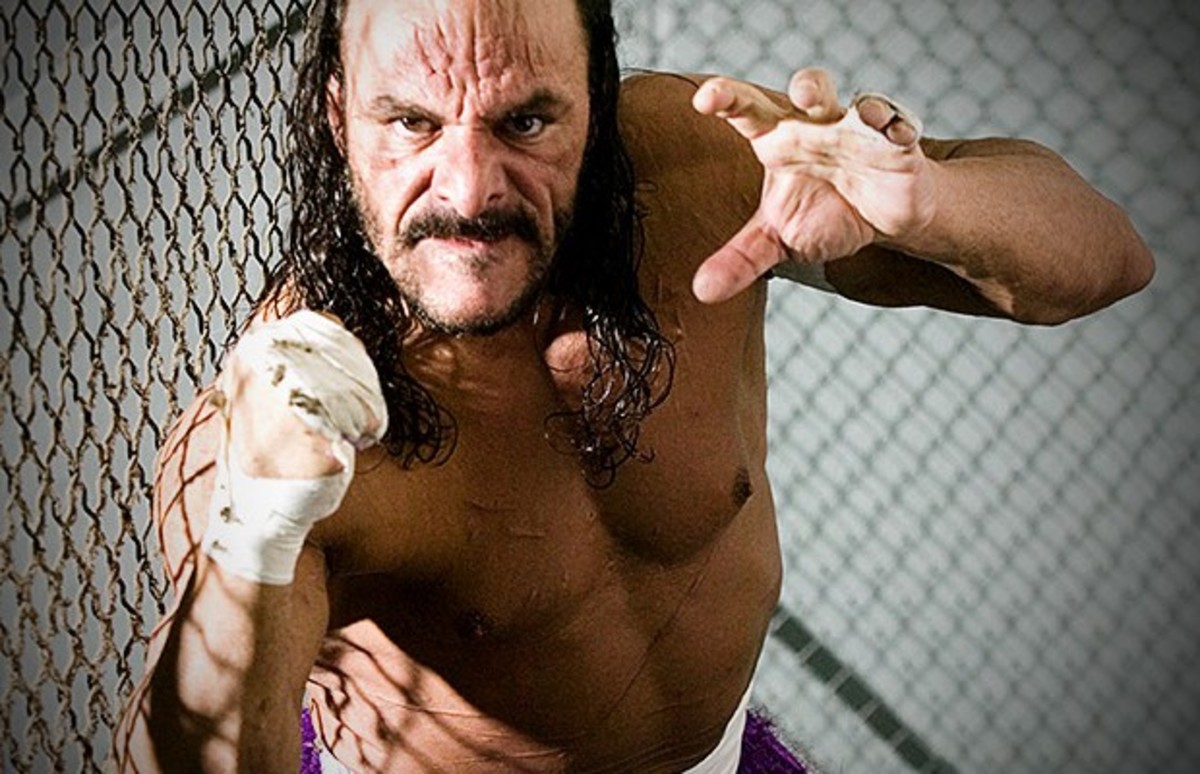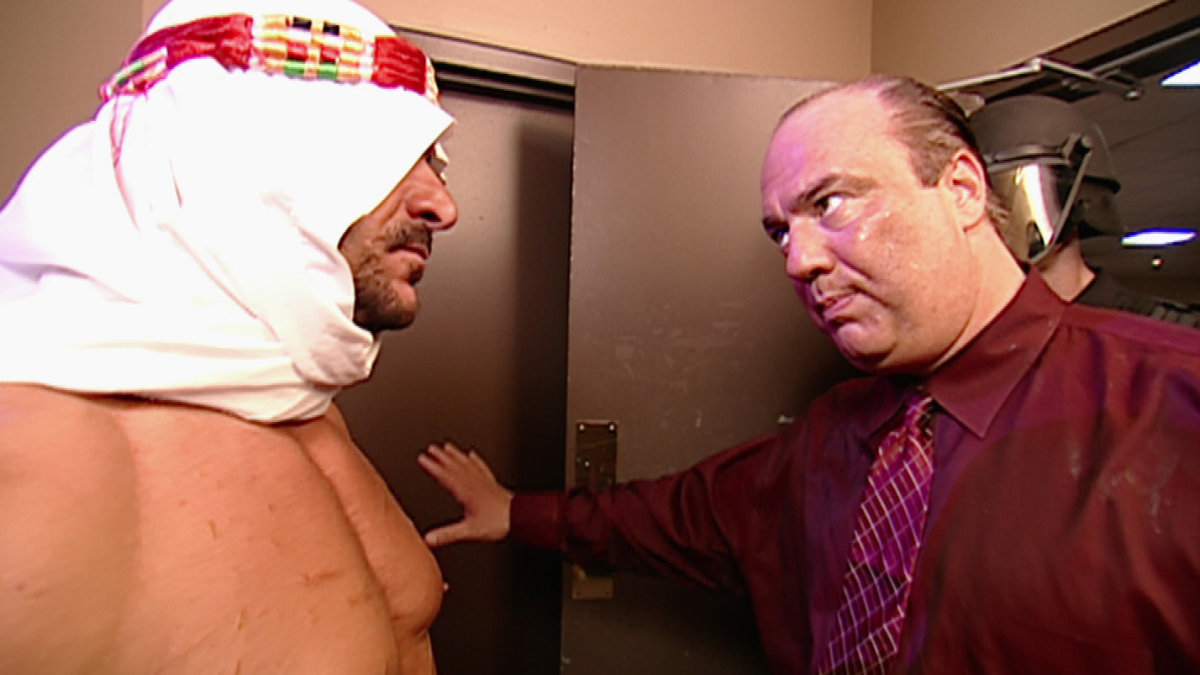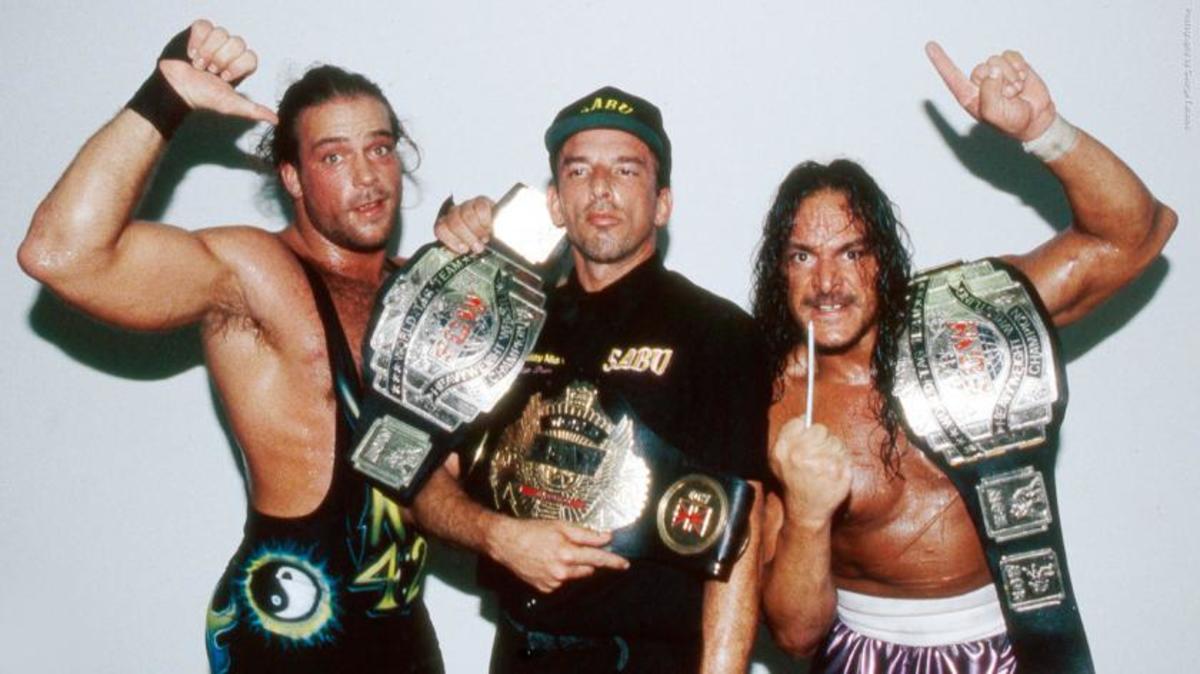At 52 and coming off a hip replacement, Sabu just wants to keep wrestling

At age 52, Sabu is paying a heavy price for his death-defying career in wrestling. After over three decades in the ring, his left hip had deteriorated to the point of bone against bone, necessitating a replacement of the pivotal joint.
Yet the only thought crossing his mind is his next match. Sabu is not retired. In fact, if you ask him, he is only recuperating from a temporary stint on the injured list.
“I have to continue wrestling,” said Sabu, known outside the ring as Terry Brunk. “I’m not done yet. I don’t know when I’ll be done, but I just know that I’m not.
“I’m doing good. I had hip replacement surgery, but I need shoulder replacement surgery and my lower back needs fixing. Those are actually more painful, but not more painful when I wrestle, so I can live with it. My hip was the most painful when I wrestled, so I got my hip fixed.”
Although he underwent successful hip replacement surgery this past October, Sabu is still in need of money for his post-operation requirements, including physical therapy.
A GoFundMe was set up for Sabu, though he is reticent to ever ask for someone to donate.
“I’d rather not talk about my health,” offered Sabu. “I’m not looking for no handouts, though I do appreciate the ones who have given.”
Sabu did not speak during his wrestling career in the ring. He was trained by his uncle, WWE Hall of Famer The Sheik, who took the business of professional wrestling so seriously that he refused to speak English in public so he would never break character.
“I took a lot of pride in that,” confirmed Sabu, who still rarely conducts interviews. “I was a little better [at separating myself from the character]. He was The Sheik 24 hours a day.
“In the beginning, The Sheik tried to make me not resemble him. Not copy him, not imitate him, so I didn’t. If I tried, from day one, to carbon copy The Sheik, it would have looked silly. In later years, I imitated him in my own way. I wanted to be an original Sabu instead of another Sheik. I took The Sheik to another level.”
Sabu’s refusal to speak only exacerbated the challenge to consistently connect with fans, and ultimately led to even more reasons to try another—and another, and another—death-defying spectacle in the ring.
“Some guys have the gift to sell out. I don’t have the gift to sell out,” said Sabu. “I didn’t make my money talking in the ring, I made my money wrestling.”

Wrestlers were rarely offered the respect that they deserved during the height of Sabu’s success in the 1990s. In Sabu’s case, his everlasting impact to the business is often overlooked, mainly because he spent the majority of his career outside WWE. Sabu’s injuries, like his style, are very real.
“No, that’s all a work, too,” he stated sarcastically, showing off his sardonic nature and fiery personality that fans only knew from his work in the ring. “All these injuries are prefabricated, and the surgeries are all fake.”
Sabu still follows the business, and he prefers to watch the wrestlers who, similar to himself, work in a captivating aerial style.
“Ricochet is awesome,” said Sabu. “That one dude, Finn Balor, is great, and that Neville is too good.
“I like to portray what I like to watch. I don’t do something that I think is boring. If I’m in a match and I have a guy in an arm bar, and I think, ‘If I was in the front row, would I think this was boring?’ If I thought it was boring, I’d get the hell out of there. I could not see having people pay me for me to bore them, even if it was for one second.”
Sabu was a hardcore legend in ECW, but never acheived the same status in WWE. Despite a career that started in 1985, Sabu’s longest single run with WWE began in 2006 and only lasted thirteen months.
“I had a little regret over [not going to WWE sooner], but I’m happy where I’m at now,” said Sabu. “There’s a few things I wish I would have done differently, but for the most part, I did things my way. I achieved some things that were told to me to be unachievable.”
One of Sabu’s first WWE feuds was with John Cena.
“I got a lot of flack before I wrestled Cena, but no flack afterward because he was good,” said Sabu. “A lot of guys mock him, but he’s a good worker.”
Cena is the modern-day face of WWE. He will never be known around the wrestling world as “King of the Death Match”, but that, explained Sabu, is not a fair indicator of his talent.
“He probably could be ‘King of the Death Match’ if he wanted, but why would he?” asked Sabu. “Why would he want to wrestle for a hundred dollars when he can wrestle for hundreds of thousands or millions? The highest paid ‘King of the Death Match’ was when I was offered $5,000. John Cena’s lowest match isn’t even five grand, so why would he wrestle in a ‘King of the Death Match’?”
Terry Funk, who is another hardcore wrestling legend, continues to say Sabu does not receive the respect he deserves from WWE.
“It doesn’t bother me that I don’t get the respect I deserve, but it bothers me that he says it,” said Sabu. “That means he’s losing more sleep than I am over it, so that bothers me. I get a lot of credit for it, but so what? Who needs credit for it?
“Rob Van Dam was asked, ‘What more do you want to accomplish in this business, or see accomplished?’ And he goes, ‘I’d rather see Sabu get credited as the pioneer that he is.’ He knows my life, he knows it more than anybody.”
Unbeknownst to him at the time, and a continent away from the oftentimes cartoonish style of wrestling in North America, Sabu kicked off an extreme revolution in wrestling during his time in Japan. He wrestled in barbed wire matches, visibly tearing up his upper frame and torso, and even took part in a “Ring of Fire Deathmatch.”
“The Sheik used to put me through such ringers that the barbed wire matches were gravy,” said Sabu. “Those other guys would say, ‘Oh man, I’ve got a barbed wire match.’ I’d say, ‘Oh man, we’ve got a barbed wire match!’ I was the only one excited for it.”
[youtube:https://www.youtube.com/watch?v=vDvnsukyHjs]
The youngest of three boys, Sabu took the brunt of the beatings from his brothers—until, that is, he learned how to fight back.
“Toughness was also instilled in me from growing up with my brothers,” he explained. “Usually they won, until I turned 15, then I started kicking both their asses. I was getting my ass kicked for 14 years, so that instilled in me the notion of not giving up.”
Sabu’s high school football career in Michigan actually foreshadowed his willingness to absorb and deliver punishment.
“I played football, baseball, and I dabbled in hockey, but I was really only good at football,” he said. “Believe it or not, I was a f---ing offensive guard. I was honorable mention and second-team All-City, but I was the smallest guy on the line. I was 147 pounds, and the next guy closest to me in weight was 250. If I were to put my heart into football, I would have done some good things in it. My heart wasn’t in football.”
To this very day, Sabu’s heart remains in wrestling. He admits he is struggling financially and is part of the class action concussion lawsuit against the WWE, yet he remains consumed—and moved—by the business.
“A lot of my stuff came to me in my sleep,” said Sabu. “When I sleep, I have a pad of paper next to me. If I have a high spot or a crazy spot that I dream of, I’d wake up and write it down. In the morning, then, I’d have it. Every week I’d go to my gym and try to piece together all the notes that came to me in my sleep. Out of that, I’d get a couple of original moves.”
Wrestling, when done well, is an art. Sabu put his mind, body, and soul into the craft. Countless wrestlers working around the globe continue to emulate Sabu, and he is grateful to have influenced so many of the current generation of wrestlers.
“That makes me feel pretty awesome,” said Sabu, before adding a caveat. “But the things they are most impressed with aren’t the things I’m best at. They don’t know what they’re impressed with, and they don’t know what I’m best at.”
Jumping through tables was a Sabu signature but only represented a small piece of his deep-rooted wrestling psychology.
“Breaking a table was a very small part of the match, usually the finish,” said Sabu. “Then it became so ordinary because everybody else was using it that it became a high spot, but none of my matches are ever built around a table.

Sabu worked closely with Paul Heyman in ECW, as well as Vince McMahon in WWE. His vision of pro wrestling, he admitted, differed from both Heyman and McMahon’s.
“Paul had his vision and I had mine,” said Sabu. “He didn’t really touch what I did, but his vision and mine were totally different. Mine was violence and his was violence, but his was also sex and violence and gross stuff, stuff out of the realm of wrestling. I was fighting for a championship, not fighting because someone got pregnant.
“Me and Vince got along. He was very hands-on, more hands-on than I’d like him to be. I thought he hired me to do my job, not hire me to show me how to do my job. He’s a very hands-on guy at everything, so hands-on that it’s a pain in the ass. He’s brilliant, and so is Paul Heyman. When you’re that brilliant, you’ve got to be f---ed in the head.
Although The Sheik was inducted into the WWE Hall of Fame in 2007, Sabu doubts that he will ever share that distinction, nor does he particularly care about the potential slight.
“It’s such a fake Hall of Fame,” said Sabu. “I’d only do it because I need the money. I don’t know if I would mother--- everyone or if I would take it graciously, but I don’t consider it a real Hall of Fame. It’s not like the Baseball Hall of Fame or the Football Hall of Fame. They let anybody in it, anybody who could draw money. The real wrestling Hall of Fames are in Iowa and Amsterdam, New York. They look for donations because they’re so broke, but they have s--- from the 1800s.
“Vince’s Hall of Fame only has s--- from Vince’s company. If you didn’t work for his company, you’re not in the Hall of Fame. That’s nothing to do with how good you are, it only matters who owned them.”
In lieu of the WWE Hall of Fame, Sabu thinks back to some of his greatest matches and moments from ECW.
“Too Cold Scorpio, I always had good matches with him,” recalled Sabu. “I only wrestled Lou Spicolli twice, but man, the two I had with him were great. Taz, of course, and I don’t care what anybody says, but I had great matches with Taz. There’s got to be some heat in there or else it ain’t no fun.”
Sabu’s greatest accomplishment may be that he earned the respect of the violence-rabid Philly fans.
“They are bloodthirsty,” bragged Sabu. “And they were my biggest city.”
As for other pro wrestlers giving back and donating to his GoFundMe, Sabu says no one is obligated to contribute (“They don’t have to,” he quickly offered), though it is important to note that Sabu always gave the only way he knew how: in the ring.
“There is no off button,” admitted Sabu. “Even the few last matches I had, which were horrible, my valet—my girl Super Genie—kept saying, ‘You can do it.’ I had a lot of pain, but I knew I was going to reach down and try any way.”
Super Genie is Melissa Coates, who is Sabu’s valet, girlfriend, and is even helping him recover from his hip replacement surgery. She is a former professional bodybuilding and fitness model.
“She’s been helping me ever since I got my hip fixed, and she’s been doing a great job,” said Sabu. “She has a hell of a body on her, and she took number nine in Ms. Olympia.”
Sabu is a man of actions, not words, but he is grateful for those who have donated to him in his time of need.
“Thank you so much for being there,” said Sabu. “My uncle always taught me, ‘If nobody sees it, it never happened,’ so thank you for being there and making it happen. Thank you for your donations, and God bless everybody.”

As for the future, Sabu has his comeback—and ultimate retirement—already mapped out.
“I want to have a one-year tour with my and Rob Van Dam’s farewell,” said Sabu. “One year of me and RVD hitting all the towns, like Tokyo, London, Detroit, Philadelphia, and Pittsburgh for one year and have a final farewell.
“Then I can retire during the last match, or we can have a closure match where we both get killed.”
Justin Barrasso can be reached at JBarrasso@gmail.com. Follow him on Twitter @JustinBarrasso.
